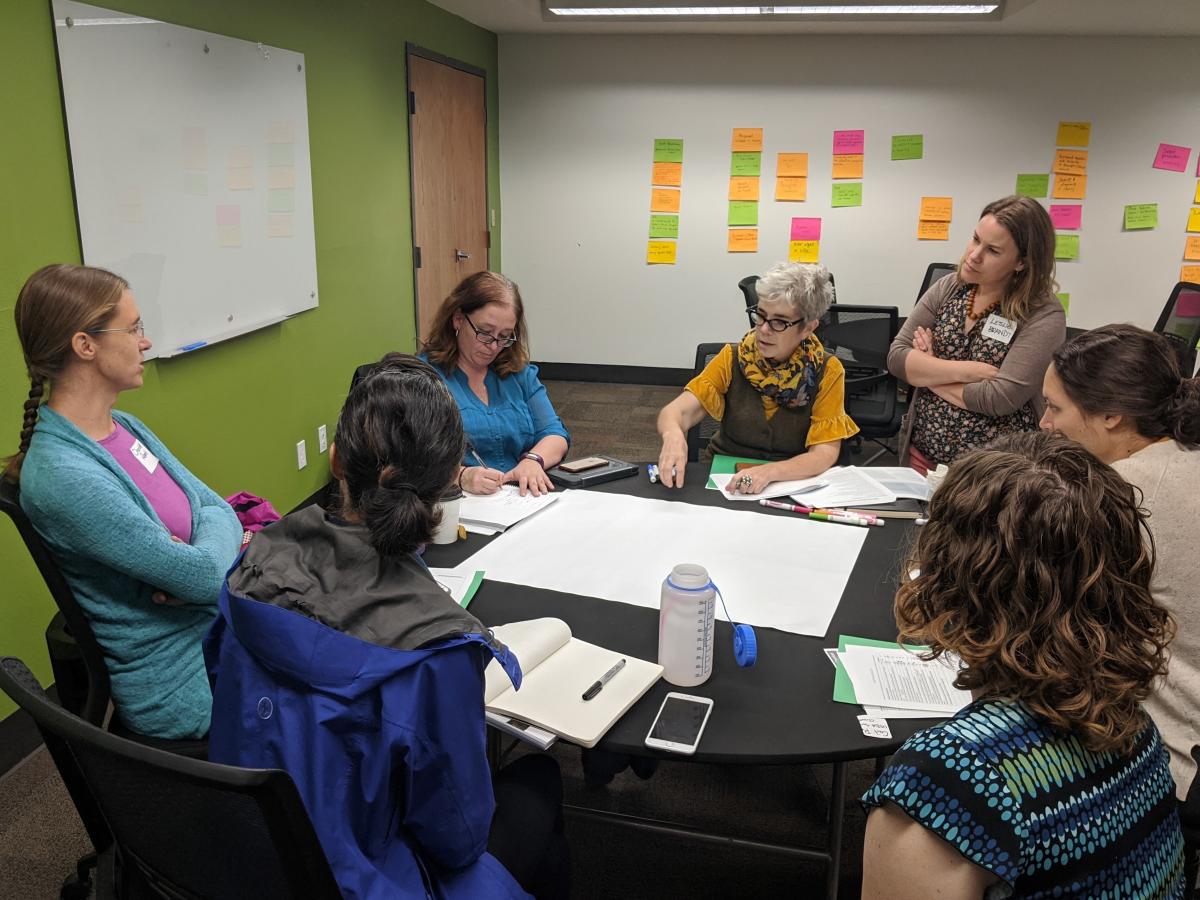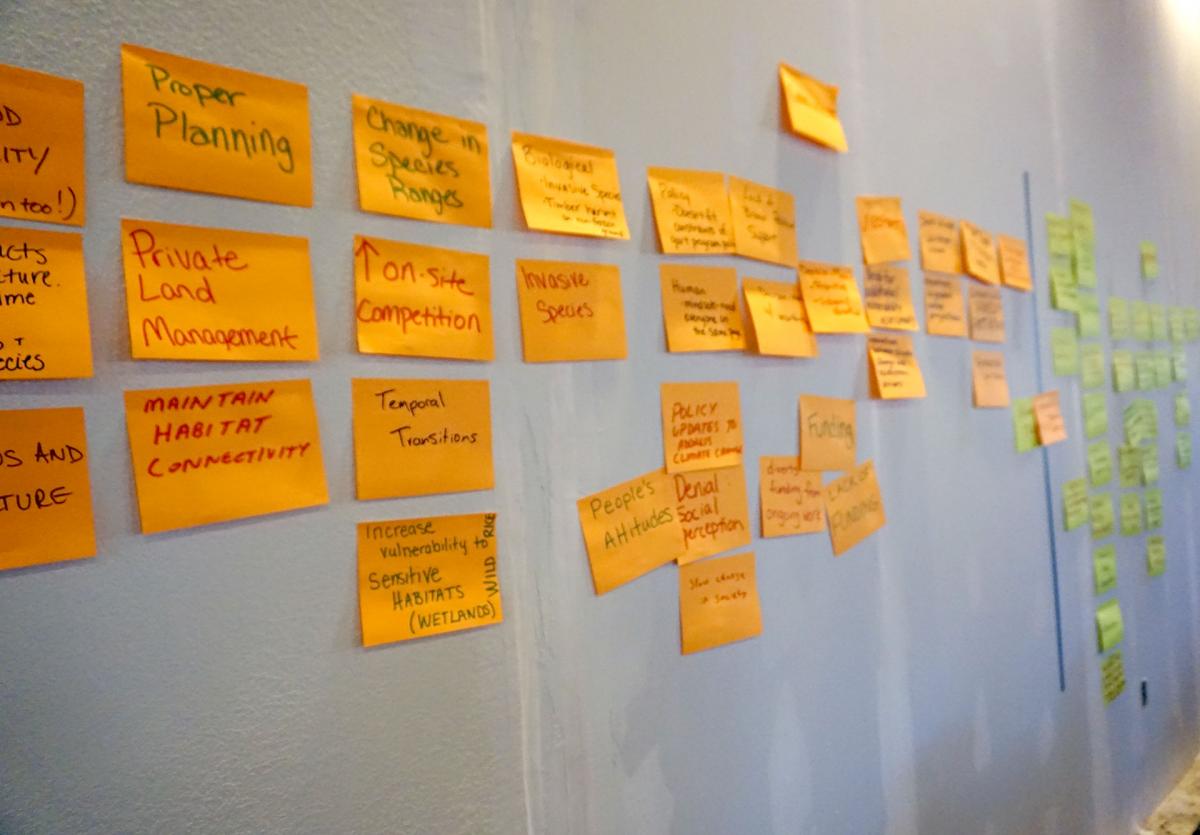The Adaptation Workbook
The Adaptation Workbook enables natural resource professionals to consider the potential effects of climate change on forests and to then design actions that can help reduce risk and increase the ability to cope with changing conditions. It provides a flexible process that accommodates a wide variety of geographic locations, scales, ecosystems, land uses, management goals, and ownership types.
The Northern Institute of Applied Science has led the development of the Adaptation Workbook. The Workbook is a structured process to consider the potential effects of climate change and design land management and conservation actions that can help prepare for changing conditions.


Why was it created?
More and more information is becoming available on climate change projections and potential impacts on natural resources and agriculture. Unfortunately, most of this information doesn't seem applicable because many land owners and managers are unsure how climate change might actually apply at the scales that are relevant to their work. The Adaptation Workbook was created to bridge this gap. It provides users with a flexible, logical process to consider climate change information and design customized management actions that can help achieve their management objectives.
Who is it for?
The Adaptation Workbook can be used by a diverse range of people working in forestry, natural resources, and agriculture, including biologists, foresters, planners, soil conservationists, and consultants. The Workbook is designed primarily for professionals, but motivated landowners will also be able to use it. People with clear management goals and knowledge about their local ecosystems can use the Workbook, whether they are making management decisions for individual parcels or across a broad landscape.
Versions of the Adaptation Workbook
The Adaptation Workbook is available in a variety of forms.
- The Adaptation Workbook: The original workbook as described in Forest Adaptation Resources: Climate change tools and approaches for land managers, 2nd Edition.
- Interactive Online Workbook:This online Adaptation Workbook has been modified from the print versions to be more interactive and self-guided. There are downloadable resources and examples to accompany every step of the process.
- Natural Resource Professionals Quick Guide:The Quick Guide was developed as an entry point to adaptation planning for natural resources professionals.
- Guía rápida para profesionales de recursos naturales:La Guía rápida se desarrolló como punto de acceso para la planificación a la adaptación para profesionales de recursos naturales.
- Land Trust Quick Guide: This Quick Guide was developed specifically to support land trusts and serve as a stepping stone for the process of adaptation planning.
- Adaptation Resources for Agriculture:This technical bulletin was developed specifically to meet the unique needs of agricultural producers.
An introduction to the Adaptation Workbook
These resources were designed for the Midwest and Northeast U.S., and are a product of a synthesis of academic literature and widespread input from the management community. However, these tools may be useful in other regions as well.
What's inside
-
Define project goals and objectives
Clearly stated goals and objectives are important for helping you and your partners and stakeholders describe exactly where you want to go. As you set up a new project, consider two fundamental questions:
- Where is your project located?
- What do you want to achieve?
-
Assess climate change impacts and vulnerabilities
Climate change will affect our natural landscapes and the human communities that depend upon them in many ways.
Although we have a wealth of information about climate change impacts nationally and regionally, climate change will affect each area differently based on the local characteristics that are unique to that place.
There are many regional vulnerability assessments that may be applicable to your area.
After describing local climate change impacts, you can rate your level of vulnerability based on the vulnerability assessments and your knowledge of site conditions:
- Low Vulnerability – Ecosystems are expected to readily cope with potential climate change impacts. Climate change is more beneficial to ecosystems than disruptive.
- Moderate Vulnerability – Climate change impacts are expected to alter ecosystems, but ecosystems will be able to cope with some impacts.
- High Vulnerability – Climate change impacts are expected to exceed the ability of the ecosystem to cope with impacts. Ecosystems may undergo changes that will disrupt important ecosystem functions and key environmental benefits.
-
Evaluate goals and objectives
Once you have identified the climate change impacts on your project area, consider how these impacts could influence the goals and objectives that you identified in the first step.
Four questions can be useful to help you evaluate your project goals and objectives in the context of climate change:
- What new or different challenges need to be addressed as a result of climate change and related stressors?
- What new opportunities might be available as a result of anticipated changes?
- Are your current management practices enough to overcome the challenges and meet your management goals and objectives?
- Do any of your goals or objectives need to change?
Once you have thought about how climate change may create challenges to, or opportunities for, your project, you may realize that there may be conditions where it may no longer be feasible to meet some of the goals and objectives that you identified in Step 1. If this is the case, this is an appropriate time to revise your goals or objectives before moving onto the next step.
-
Identify and implement adaptation actions
You may need to alter your management practices to address new or increased challenges associated with a changing climate and environmental conditions.
Identifying potential challenges and opportunities will position you to take action and adopt practices that will maximize the benefits your natural areas provide for ecosystems, wildlife, and human visitors.
-
Monitor and evaluate effectiveness
Monitoring is about asking the right questions that will help you ensure desired outcomes over time.
There are different types of monitoring that you’ll encounter in science and management. In scientific research, we may have a question and a hypothesis, and with quality replication we can judge deviation through time.
This level of rigor can be challenging to implement because of the financial costs, and time and effort involved.
Instead, the focus should be on evaluating whether you are achieving the goals and objectives that you identified at the outset of the project and to what extent your actions were effective in helping you meet those goals and objectives.
Adaptation menus
One of the five steps is identifying adaptation approaches and tactics for implementation. The collection of topical adaptation menus provides a curated list of potential adaptation strategies and approaches. Although menu items can be applied in various combinations to achieve desired outcomes, not all items on the menu will work together. Furthermore, actions that work well in one ecosystem type may not work in another; it is up to the land manager to select appropriate actions according to project location and goals.

